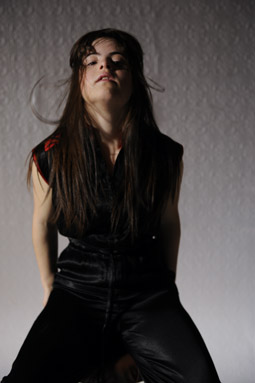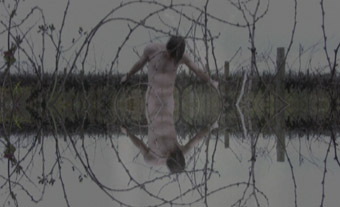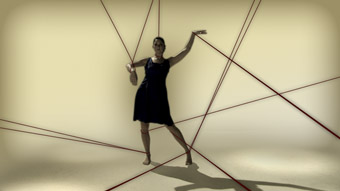dancefilm: making choices
karen pearlman: 2010 reeldance awards

Jianna Georgiou, Sixteen by Sophie Hyde
photo Andy Rasheed
Jianna Georgiou, Sixteen by Sophie Hyde
THIS YEAR’S REELDANCE AUSTRALIA AND NEW ZEALAND AWARDS INCLUDED ALL THREE OF THE MAIN GENRES OF SCREENDANCE: DANCE-DRIVEN ‘DANCE ON CAMERA’ AS SEEN IN STRAND (MICHAELA PEGUM, SIOBHAN MURPHY AND DOMINIC REDFERN), VISUAL ART DRIVEN ‘VIDEO DANCE’ AS IN SHADOW IN BLUE (ZOE SCOGLIO) AND CINEMATIC DANCEFILM AS IN ALMOST ALL OF THE OTHER PRODUCTIONS SCREENED.
This impression of a strong cinematic sensibility comes from the award program being dominated by the work of a filmmaker (rather than a choreographer), Sophie Hyde, who directed three of the 10 works shown. Her works convey their meanings through mise en scene, montage and especially sound scores (by DJ TR!P, an indispensable collaborator). The three films form the Necessary Games ‘triptych’ performed by Restless Dance Theatre in South Australia, a company of mixed ability dancers.
The best of these, Sixteen (choreographed by Kat Worth), won the award for best dancefilm. It’s a sweet portrait of a young woman’s playful, physically expressed encounters with different men. The character’s disabilities are neither the text nor the subtext of the work, they are a given, which is not particularly remarked upon. Instead we are invited, through the frames within frames of a photographer’s studio where the piece is set, to see different qualities of relationship and a girl taking charge of her choices.
Slightly less successful in its creation of drama and relationship is Moth (choreographed by Paul Zikovich), which juxtaposes the moves of a young man with Down’s syndrome against those of a lean and muscular, able-bodied dancer. The pairing of these two, though adroitly shaped, felt a bit strained. That said, Moth had the most brilliant editing of the evening, with cuts creating movement dynamics and patterns of time that are as much ‘the dance’ as the movement of bodies.
The least engaging of the triptych, Necessity (choreographed by Tuula Roppola), was also, to me, the least successful in creating a cinematic experience of movement. It felt more like a recording of a dance than a cinematic construction, using close-ups for the small gestures and wider shots for the bigger gestures. This raises a problem not present in the other two: would I be interested in this if not for the unusual aspect of a disabled person dancing? I would be interested in Sixteen and Moth, but in this one, I wasn’t so sure.
The runner-up prize-winner was Tap Hop Lesson 1 (by Soda Jerk) a mash up of two pieces of archival footage—one a 1930s American movie in which a group of black men entertain the white folks gathered at a glamorous party, the other a 1980s television studio shoot of some guys doing hip hop. We’re invited to compare these alternating scenes, one on the left, the other on the right side of the screen, with little comment, except for their juxtaposition, until the soundtrack from one is laid under the images of the other so the Jazz and Tap of the 1930s becomes the ‘lesson 1’ for Hip Hop of the 80s. Aside from this slight if entertaining insight, this piece does not explore the implications of racial stereotyping and spectatorship to which it alludes.

Saint Sebastian, James Welsby
Saint Sebastian (by James Welsby) winner of the “Encouragement Award” is an accumulation of images of lonely, vulnerable men making a strong reference to the eponymous tortured saint. The figures on screen are positioned as objects of beauty and pity, but the images constructed neither use the tools of visual art to create a sensual experience of beauty, nor the functions of cinema which would align us with the figures as characters and allow for the emotional engagement of pity.
The only ‘dance-driven’ piece on the evening was Strand, a sometimes glorious and more often maddeningly frustrating piece for two lovely dancers executing choreography in a sea of desert. There is one stunning camera angle in this piece, a long shot in which the dancing is contextualised in vastness—making it poignant, absurd and, in a way, fierce, in its battle against the odds of the space. But cutting closer in is unmotivated. It displays the dancing, but it frustrates the desire for the cinematic piece this could have been with more canny cuts and characters, or the visual artwork it might have been had it stayed with its one beautiful shot.
The only visual art driven ‘videodance’ on the night, Shadow in Blue, displays a lot of cool stuff that can be done with the effects palette on digital editing systems. But it also raises the question of duration. If the objective is to present a kaleidoscope of effects, shouldn’t it be up to the viewer to decide how long the toy will fascinate? Does the duration of this piece add to its meaning and justify its exhibition in a festival context or would it have more life on a gallery wall?
Motel Of Deception (Chrissie Parrott and Nancy Jones) wryly translates Neo Noir into a cleverly framed and surprisingly acrobatic set of physical relationships while keeping firmly rooted in the genre and the pleasures it affords. The textures of the seedy motel room, the deceptions framed in mirrors, the dance moves creating character and story all make for clever and engaging subversion of both the sincerity of dance (“the body never lies”) and the irony of Noir.
Tank Man Tango (Deborah Kelly) plays with documentary by suggesting that a fragment of news footage is actually a piece of choreography, and then documenting a project in which the instructions for executing that choreography travel the world and become a political ‘flash mob’ dance in commemoration of the victims of military force at Tiananmen Square. Playful yet pointed, this doco and the underlying dance achieve something rare: reminding us to care while adroitly avoiding a scolding.

Reading the Body, Sue Healey
Finally, Reading the Body (Sue Healey) one of the most fully realised works of the evening, and certainly the most fluent integration of dance, art and cinema, offers a revelation which only cinema could give us, as well as finely balanced beauty and an articulate and sensitive dance. Healey overcomes the frequently experienced gap in comprehension between the dance and its audience by revealing, with animations, the inside of the body. These revelations are timed and phrased to punctuate, extend and interact with the dancer. The cinematically constructed relationship between the animations and the dancer align us with the character, make us feel what she feels, and give us access to the mysteries of dance.
Judges for the 2010 awards were Ross Gibson, Professor of Contemporary Arts, University of Sydney, Helen Simondson, Manager of Screen Events, Australian Centre for Moving Image, Shona McCullagh, Award Winning Dance on Screen Artist, Clare Stewart, Director of Sydney International Film Festival and Adrian Martin, Senior Lecturer in Film, Monash University.
–
Reeldance Australia & New Zealand Dance Awards, Reeldance Festival, Performance Space; CarriageWorks, Sydney, May 16
RealTime issue #97 June-July 2010 pg. 26






